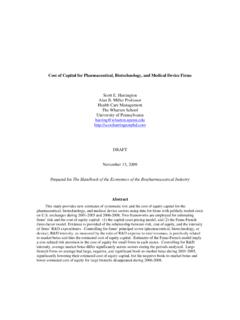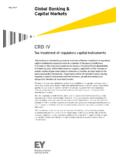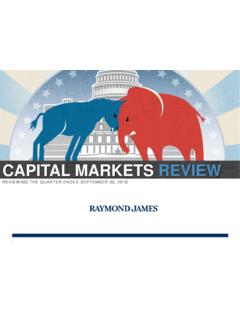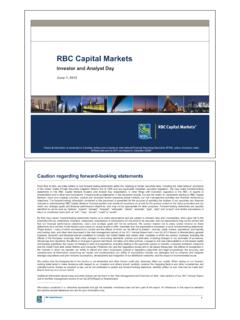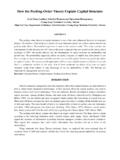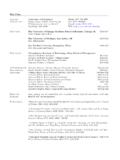Transcription of Capital Adequacy in Insurance / Reinsurance
1 Capital Adequacy in Insurance and Reinsurance Scott E. Harrington University of South Carolina Revised May 2003 I. Introduction Increased cross-sector and cross-border competition among financial institutions has led to considerable discussion of possible revisions in traditional Insurance / Reinsurance solvency regulation, including possibly greater regulatory centralization and harmonization within the United States ( ) and the European Union ( ). Important issues include a possible extension of the Basle approach to bank Capital regulation to Insurance , possible expansion of direct regulatory supervision and Capital requirements for international reinsurers, possible development of mutual recognition systems across national borders, and possible expansion of consolidated or more centralized regulatory oversight.
2 This paper deals with Capital Adequacy and Capital regulation of insurers and reinsurers. I first review the main risks, degree of market discipline, and scope of solvency regulation in Insurance and Reinsurance markets, with an emphasis on the Given that background, I next consider key principles of efficient Capital regulation, focusing on the relation between optimal Capital requirement stringency and market discipline. I then briefly describe and evaluate in relation to those principles Capital requirements and related supervision of and insurers and reinsurers.
3 I compare the and systems, consider the implications of possible federal Insurance / Reinsurance regulation in the , and discuss whether regulation of reinsurers should be expanded abroad. I also briefly discuss pressure for consolidated regulation of financial conglomerates that include Insurance and for greater centralization of regulatory authority over financial firms. My main conclusions are: Edited version published in H. Scott, ed., Capital Adequacy Beyond Basel:Banking, Securities, and Insurance , Oxford University Press, 2005 Harrington Capital Adequacy , 1/18/2005 21.
4 Capital standards (and, more generally, regulatory solvency supervision) should be less stringent for sectors characterized by greater market discipline and less systemic risk. 2. Market discipline is greater and systemic risk is lower for Insurance than in banking. Capital requirements therefore should be less stringent for insurers than for banks. 3. Market discipline is generally greater in Reinsurance (wholesale) markets than in direct Insurance (retail) markets. Capital requirements and related regulation need not be as stringent for reinsurers as for direct insurers.
5 4. Current Capital requirements and related solvency regulation for and insurers and reinsurers are largely consistent with significant market discipline in the Insurance and Reinsurance sectors. 5. Any federal regulation of insurers/reinsurers, harmonized regulation of reinsurers, consolidated oversight of financial conglomerates, and increased centralization of regulatory authority to supervise Insurance and other financial activities should be designed with full recognition of the limited systemic risk and strong market discipline in Insurance / Reinsurance and avoid undermining that discipline.
6 II. Risk, Market Discipline, and Solvency Regulation in Insurance and Reinsurance Insurance Risk Non-life (property-casualty) insurers face a variety of risks including underwriting risk, which encompasses premium and reserve (technical provisions) risks, credit risk, asset (market) risk, and interest rate risk. Asset risk is generally modest, reflecting heavy investments in government or highly rated bonds. Although many non-life insurers have greater asset than liability durations, interest rate risk is relatively modest, in part because payments to policyholders are not highly correlated with interest rate increases.
7 Credit (counterparty) risk is largely related to Reinsurance transactions, which are widely employed to manage underwriting and reserve risks. Underwriting risk is paramount for non-life insurers. Premium and reserve risks both reflect the possibility of large errors in predicting ultimate claim costs. When insurers write coverage, there is always some risk that claim costs will exceed those predicted. Similarly, once claims have occurred, the provisions for unpaid claim liabilities may prove deficient. Premium risk and reserve risk differ in timing. Premium risk involves possible divergence between ultimate costs Harrington Capital Adequacy , 1/18/2005 3and conditional forecasts of costs at the time policies are priced.
8 Reserve risk involves possible divergence between ultimate costs and conditional forecasts of costs after claims have occurred (or are assumed to have occurred in provisions for incurred but not reported claims). In either case, ultimate claim costs may substantially exceed those predicted when policies are priced and written. Natural or man-made catastrophes ( , Hurricane Andrew and the World Trade Center bombings in the ) can create large, sudden increases in costs for property and related covers. More benign changes in whether and unexpected changes in property repair costs also create risk.
9 For long-tail covers, such as general liability, ultimate claims may not be known for many years after policies are priced and written, giving rise in some cases to enormous reserve risk long after policies have been sold (as has been vividly documented in the asbestos and environmental arenas). Both forms of underwriting risk are aggravated by relentless price competition in many non-life Insurance markets, which may encourage prices to become arguably too low during soft market episodes of the Insurance cycle (see Danzon and Harrington, 1994). Subsequent negative shocks to Capital have occasionally led to very hard markets characterized by scarce Capital , large rate increases, and less favorable coverage terms, often with material effects on real (non-financial)
10 Non-life insurers hold relatively large amounts of Capital compared with their life insurer brethren and commercial Holding that Capital involves material tax and agency Depending on the jurisdiction, double taxation of returns from investing Capital to support the sale of policies significantly increases the cost of Capital and the prices needed to offer coverage, especially for low probability events with large potential severities (see Harrington and Niehaus, 1 Effects on real activity were widely reported during the mid 1980s liability Insurance crisis and more recently in the medical care sector.)
